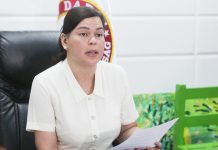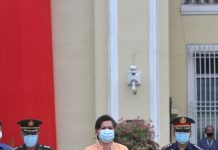Despite being cited twice as “the most child-friendly city” in the country in 1999 and 2000, the number of children in conflict with the law and victims of human trafficking and prostitution has increased in the past two or three years.
This, according to Davao City councilor Leah Librado, chair of the committee on women, children and family relations, and action officer of the Council for the Welfare of Children (CWC), during the city’s opening salvo of the 18th National Children’s Month last October 4.
Despite the recent passage of the Juvenile Justice and Welfare Act, she said, “We still see innocent children languishing in jails along with hardened criminals, child offenders involved in petty crimes dealt with the full force of the law, children wasting their lives away through drug and substance abuse.”
Based on the 2008 annual report of the City Planning and Development Coordinator, there were 4,599 reported cases of abuse of children. The 2009 report remains to be completed by the end of the year.
Children in conflict with the law
Recently, the major problem identified was the growing number of children in conflict with the law (CICL), said Grace S. Frias of the City Social Services and Development Office (CSSDO) during Club 888 forum at The Marco Polo Davao last October 6.
Police Superintendent Anna Ma. Balabad of the Davao City Police Office (DCPO) earlier said at the Kapehan sa SM that top cases of CICL were murder, crimes against chastity, robbery and theft.
From January to June this year, the CSSDO recorded a total of 273 cases of CICL, and 88 cases of minors engaged in street riots.
According to ranking, the CICL cases consist of (1) theft with 166 cases, (2) concealing deadly weapons 28, (3) illegal gambling 15, (4) physical injury 13, (5) violation of RA 9165 or comprehensive dangerous drug act 13, (6) robbery 10, (7) rape 9, (8) firecracker ban 8, (9) murder 6, (10) frustrated murder 3, (11) gun ban 1, and (12) violation of RA 8048 one.
Some of these children are currently undergoing the community diversion program, and intervention program (for 15 years old and below), while others are housed in the DSWD Regional Rehabilitation Center for Youth.
According to the DSWD, there were 345 cases of CILC served, while 76 children in Bago Oshiro are undergoing rehabilitation.
While Frias said most children in conflict with the law are out-of-school, Leah Y. Genson, vice chair of the Council for the Welfare of Children, and executive director of UCCP Pag-ugmad sa Kabataan Foundation, noted the need to provide all children with education.
Genson added that with more monetary support for education, the problems concerning children will be minimized.
Eliza Apit of the Kamalayan Development Foundation and chair of the Participation Committee Council for the Welfare of Children said that while the city’s performance in protecting and upholding children’s rights was commendable, there is a challenge to intensify and strengthen its victories.
She mentioned that the city was the first in the country to implement a children code and has a clear and huge fund for children’s welfare.
Since the implementation of the Juvenile Justice and Welfare System, Frias said, Lamdag sa Kabataan, a temporary residential facility located near the San Pedro police station, was provided as custody of children upon court resolutions.
A community-based program called diversion program, will rehabilitate the children in the community instead of bringing them to the center, according to the DSWD. Additional social workers assigned to each barangay in the city were also trained to handle children in conflict with the law.
As for Librado, “We, as stakeholders, should then be adamant in our pursuit of helping such children become productive again and provide opportunities for their re-integration to mainstream society.”
“The revised Local Development Plan for Children of Davao City for 2007-2010 is being implemented to address the many growing concerns and changes related to the city’s program for children using the rights-based approach,” she said.
Children’s month
With this year’s theme, “Kung Bright Child ang Gusto, Mundo’y Ingatan Mo,” the national children’s month highlights the growing concern to nurture bright, dynamic and productive children, Librado said.
“In so doing, we provide them the environment where their rights are guaranteed in the different stages of their growth and development, and more importantly, an environment that is safe, a world that is taken cared of and not abused.”
As part of this celebration, the DSWD, in partnership with the DCPO, conducted a search for a child-friendly police station in the city. Ester A. Versoza, DSWD regional director, said this search is dedicated to the children, which is timely in the children’s month celebration.
Acknowledging the presence of a women’s and children’s desk in every police station, Versoza said there will be an assessment of the skills of the police and the existing facilities in the station.
Aside from raising the morale and achievements of the police, the search for a child-friendly police station will encourage competition among police stations, especially in the treatment of children in conflict with the law.
Hoping to make it a region-wide search in the next two years, Versoza said Davao City was chosen as a pilot city to conduct the search because aside from being highly-urbanized, it passed the qualifications.
Haunting injustices
Ironically, this child-friendly city, despite being so, is still burdened with injustices from summary killings, including children, since more than a decade ago.
In the report presented by the Kabataan Consortium, Inc. to the Department of Justice (DOJ), Commission on Human Rights and the United Nations, since August 19, 1998 until August 25, 2009, a total of 913 victims of summary executions were recorded. [Lorie Ann A. Cascaro]
Among the total victims, 82 were children, with 12 years old as the youngest victim, and 15 years old as the youngest female victim. The highest total number of victims was in 2008 with 180 and 16 of them were children. But, the highest number of children victims was in 2007 with 17.
Most of them were killed by gunshot, and while majority of the executions had no given reason, mostly identified were drugs and theft/robbery.
According to Emmanuel C. Roldan, executive director of Kabataan Consortium, Inc., the DOJ already said the findings will be given out this year, and yet the waiting for justice to be served continues until today.
In celebrating the children’s month every year, as Librado put it, “we see the growing consciousness of society to continuously care for our future by taking care of Mother Earth today and tomorrow’s children.”
But, as the saying goes, there’s more than meets the eye. The city has yet to face a greater challenge beyond giving children protection and welfare.






